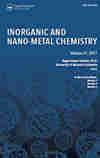Optical and Thermal Properties of Polycarbonate–TiO2 Nanocomposite Film
Synthesis and Reactivity in Inorganic, Metal-Organic, and Nano-Metal Chemistry
Pub Date : 2016-04-02
DOI:10.1080/15533174.2014.988821
引用次数: 15
Abstract
Properties of polycarbonate and polycarbonate–TiO2 nanocomposite films were studied by X-ray diffraction analysis (XRD), FTIR spectroscopy, UV-Vis, and thermogravimetric analysis (TGA). The optical band gap values were found to reduce from 4.3 to 3.5 eV with increase in TiO2 content of nanocomposites. The influence of TiO2 nanoparticles in the polymer thermal degradation was determined by the Broido method and calculating the activation energy. The activation energy is higher for all nanocomposite compare with PC and it means higher thermal stability of nanocomposite. In addition TGA carves showed that nanocomposite films have higher resistance to thermal degradation compared to PC.聚碳酸酯- tio2纳米复合薄膜的光学和热性能
采用x射线衍射分析(XRD)、红外光谱(FTIR)、紫外可见光谱(UV-Vis)和热重分析(TGA)研究了聚碳酸酯和聚碳酸酯- tio2纳米复合薄膜的性能。随着TiO2含量的增加,纳米复合材料的光学带隙值从4.3 eV降低到3.5 eV。采用Broido法测定TiO2纳米颗粒对聚合物热降解的影响,并计算活化能。与PC相比,所有纳米复合材料的活化能都更高,这意味着纳米复合材料具有更高的热稳定性。此外,热重分析表明,纳米复合材料薄膜比PC具有更高的热降解性能。
本文章由计算机程序翻译,如有差异,请以英文原文为准。
求助全文
约1分钟内获得全文
求助全文
来源期刊
自引率
0.00%
发文量
0
审稿时长
5 months

 求助内容:
求助内容: 应助结果提醒方式:
应助结果提醒方式:


